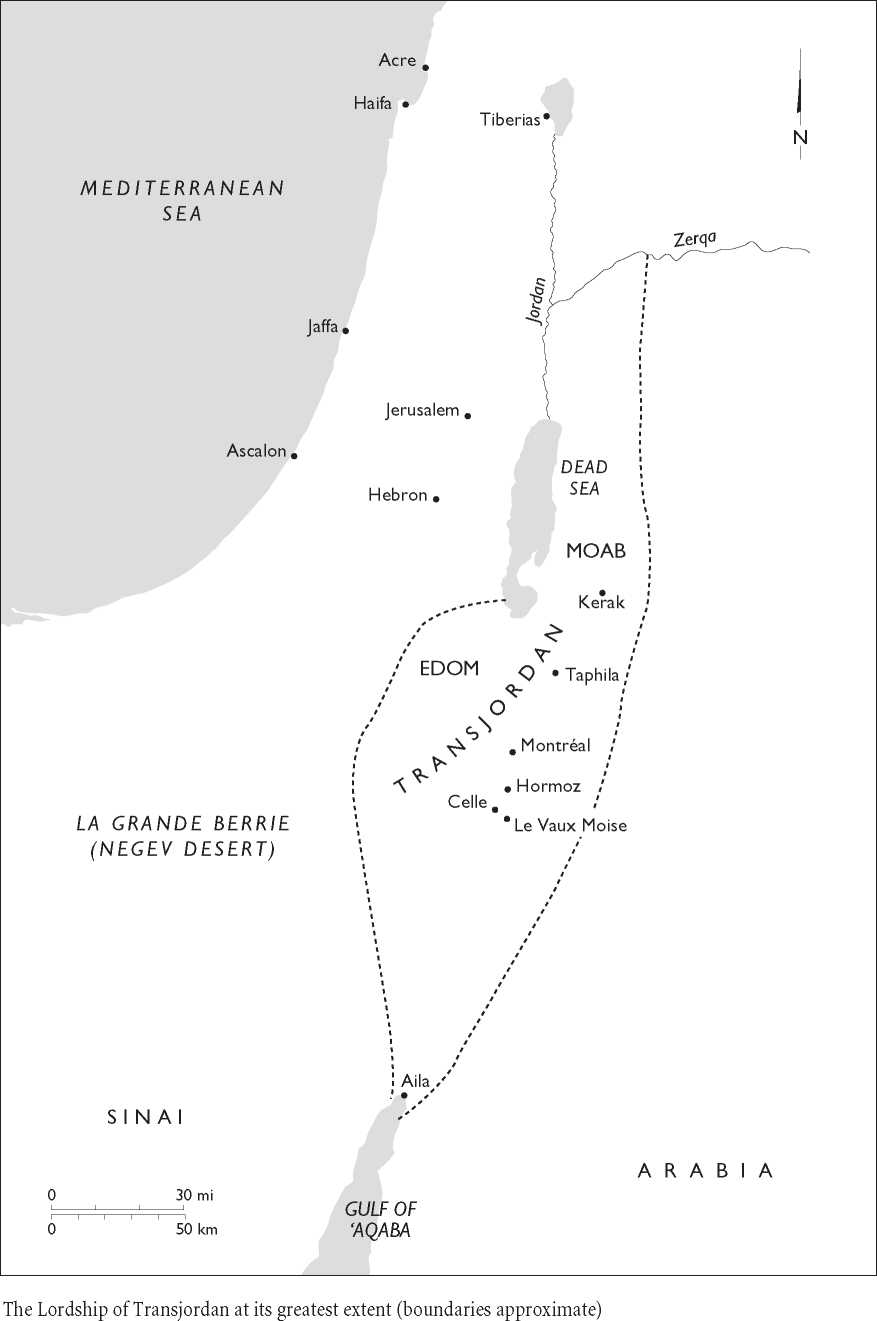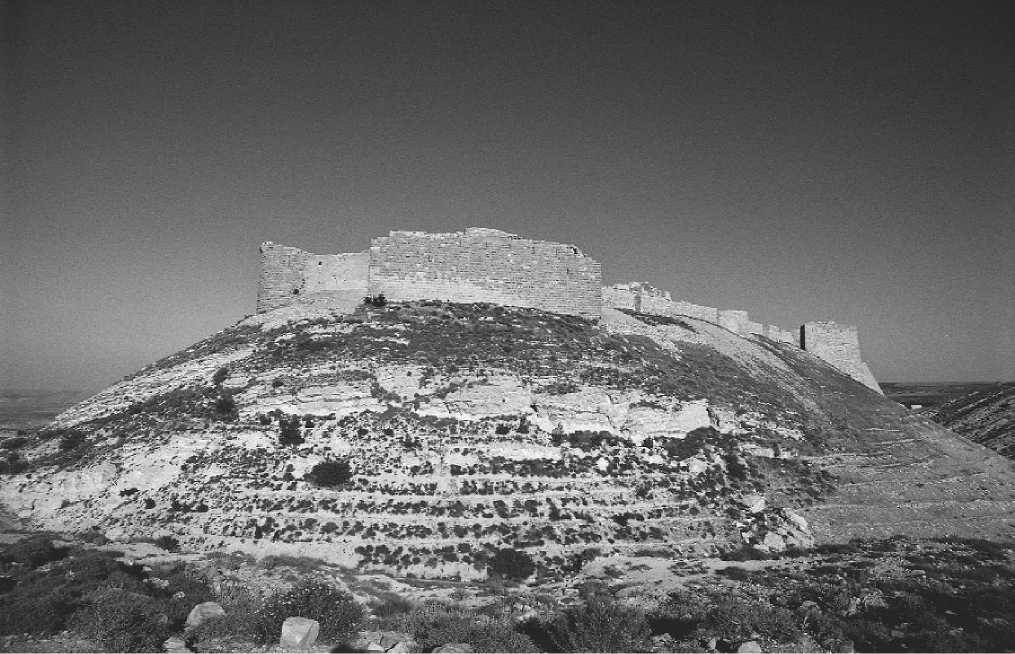Transjordan (Fr. Oultrejourdain) is a modern designation for one of the main lordships of the kingdom of Jerusalem, situated to the east and south of the Dead Sea and covering the biblical lands of Moab and Edom (Idumaea).
The Franks first penetrated this region in the year after the conquest of Palestine by the First Crusade (1096-1099), when King Baldwin I of Jerusalem led an expedition to reconnoiter the area south of the Dead Sea in November-December 1100. Further reconnaissances and raids followed, but a permanent Frankish presence was only established in 1115-1116, when the king constructed the castle of Montreal (Lat. Mons Regalis) at Shaubak in Edom. Under Baldwin I the entire region remained part of the royal demense, but Baldwin II formed Moab and Edom into a lordship for Roman of Le Puy, whom, however, he later dispossessed for rebellion (probably before 1126). Roman’s successor, the royal butler Pagan, constructed a larger castle in 1142 at the town of Kerak (mod. Karak, Jordan) in Moab, east of the Dead Sea, which became the new capital of the lordship.
After the death of the third lord, Maurice (c. 1153), the territory reverted to the royal demesne until 1161, when Baldwin III gave it to Philip of Nablus in exchange for the latter’s fiefs in Samaria, and added to it the lands to the south as far as Aila at the head of the Gulf of ‘Aqaba. When Philip joined the Order of the Temple (c. 1166), he was succeeded first by Walter III Brisebarre (husband of his elder daughter Helena), and in 1174 by Miles of Plancy (husband of his younger daughter Stephanie), who, however, was murdered later the same year, possibly at the instigation of the Brisebarre family. The lordship was kept vacant until 1177, when Baldwin IV gave Stephanie in marriage to Reynald of Chatillon, who received Transjordan together with the neighboring fief of Hebron.
Transjordan ranked as one of the four major lordships of the kingdom of Jerusalem, owing the service of forty knights to the king. Nevertheless, the number of resident Franks was small, probably consisting mainly of garrisons and their families. There were few Latin churches and no Latin monasteries. A metropolitan see was established in 1168; although its title derived from the ruined city of Petra, the archbishops resided in Kerak. The settled population of the lordship consisted predominantly of Syrian Christians with smaller numbers of Muslims, concentrated in the two fertile regions around Kerak and Montreal, which produced an abundance of wheat, olives, wine, sugar cane, fruit, salt, and other products. In addition to their two major fortresses, the Franks held smaller castles at Taphila, situated midway between Kerak and Montreal, and at Le Vaux Moi'se (mod. Wadi Musa, Jordan), Celle (or Sela), and Hormoz, all to the south of Montreal. This chain of strong points gave the Franks possession of most of the main water supplies as far as the Syrian desert for a distance of over 100 kilometers (c. 60 mi.) south of Kerak, and for most of the twelfth century, the lordship not only protected the kingdom from attack from the southwest, but also controlled the main trade route from Muslim Syria to Egypt and the Hijaz. Muslim traders were obliged to pay tolls to obtain passage (which constituted an important part of the lordship’s income), while Muslim armies moving between Syria and Egypt were impeded by having taken a more difficult route to the east of the Transjordanian castles.
By 1161 Frankish Transjordan stretched from the river Zerqa (a tributary of the Jordan) in the north to the Red Sea in the south. Although separated from the rest of the lordship by some 90 kilometers (c. 55 mi.) of uninhabited territory, the southern strong points of Aila and the Ile de Graye (Pharoah’s Island) in the Gulf of ‘Aqaba controlled the main road from Egypt across the Sinai peninsula to Arabia. From these bases the Franks could prey on pilgrims going to Mecca as well as traders, and even impede the movement of Muslim armies. Aila therefore posed a significant threat to the empire of Sal-adin after his conquest of Egypt (1169). He besieged and captured it in December 1170 and invaded Edom in 1171 and Moab in 1173. However, in late 1181 Reynald of Chatillon retaliated with an audacious raid that bypassed Aila and struck deep into Arabia; in the winter of 1182-1183 he transported ships from Kerak to the Red Sea, which blockaded the Ile de Graye and preyed on Muslim shipping until they were defeated by a fleet organized by Saladin’s brother al-‘§dil. Two subsequent sieges of Kerak by Saladin were repulsed by Frankish relieving armies (1183, 1184), but Saladin’s great victory at Hattin (July 1187), at which Reynald was captured and executed, left Transjordan exposed. Kerak capitulated in late 1188 and Montreal in the spring of 1189.
The Franks cherished hopes of recovering Transjordan well into the thirteenth century, and claims to the lordship


Castle of Montreal in Transjordan, built by King Baldwin I of Jerusalem in 1115, which fell to Saladin in 1188. (Erich Lessing/Art Resource)
Passed to the family of the lords of Toron. However, Saladin’s Ayyubid heirs had too great an appreciation of the region’s strategic significance to risk it again passing under Frankish control, as it formed the vital link between the Ayyubid possessions in Syria and Egypt. Thus when the sultan al-Kamil offered to surrender Saladin’s conquests in Palestine as the price for the withdrawal of the Fifth Crusade from Egypt (1219), he specifically excluded Kerak and Montreal from any concessions. Transjordan was also excluded from the territories he conceded by treaty to Emperor Frederick II in 1229.
-Alan V. Murray
Bibliography
Deschamps, Paul, Les Chateaux des croises en Terre Sainte, vol. 2: La defense du royaume du Jerusalem (Paris: Geuthner, 1939).
Hamilton, Bernard, The Leper King and His Heirs: Baldwin IV and the Crusader Kingdom of Jerusalem (Cambridge: Cambridge University Press, 2000).
Mayer, Hans Eberhard, Die Kreuzfahrerherrschaft Montreal (Sobak): Jordanien im 12. Jahrhundert (Wiesbaden: Harrassowitz, 1990).
Prawer, Joshua, The Latin Kingdom of Jerusalem: European Colonialism in the Middle Ages (London: Weidenfeld and Nicolson, 1972).




 World History
World History









